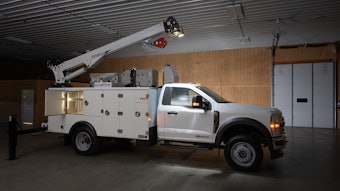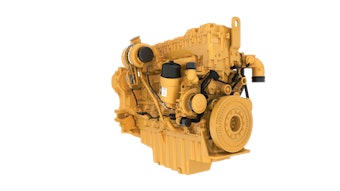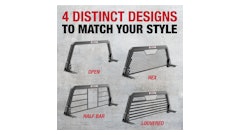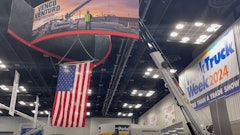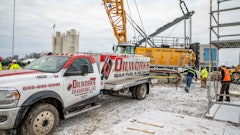As vocational trucks continue to grow in complexity and sophistication, companies are under increasing pressure to maximize their vehicle investments. This process should start well before a new work truck is ordered. No longer is it prudent just to buy what you've always bought. To keep your vehicle maintenance and operation costs down, you need to do some homework before making another call to your truck dealer.
Start by establishing and following a logical design process, as outlined here in four steps. Taking a systematic approach to specifying a new work truck makes it easier to ensure that the truck meets your needs.
Step 1. Determine what you need the truck to do.
Start by asking yourself what the vehicle will be used for. Exactly what will you haul with it? How far will it be driven and how often? What special circumstances will your drivers/operators encounter and how often? Don't just say, "I need a pickup truck." Really explore what that pickup truck has to do in order to be most productive.
For example, does your truck need to haul equipment? Does the operator need to be able to get equipment on and off the truck frequently? Do you need to haul material to job sites? What kind of material are you hauling and how much? Will the truck have different uses at various times of the year? (For example, will it be used to plow snow in the winter?) How many workers will the truck carry regularly?
Think about the environment in which the vehicle will be driven and used. Consider how available features can improve or hinder operator productivity. Spend some time looking at the performance of the trucks you have now. Talk to your vehicle operators and maintenance crew to see which trucks and equipment they prefer, and why.
Step 2. Thoroughly explore technical details to achieve your vehicle goals.
Now that you've identified what you want the vehicle to do, it's time to figure out how to make it happen. For example, if you have determined that the truck needs to carry six #3 widgets, defining how big those widgets are will impact the vehicle's bed size, and how much the widgets weigh will affect the vehicle's payload requirements.
Questions to ask include: What are your performance requirements, such as speed with a full load, braking considerations and fuel economy? What type of truck body and/or special equipment is needed? Be sure to account for the size of special equipment to be upfitted to the chassis, the weight of these components, cargo storage needs, component installation requirements and operational requirements (i.e., power sources for equipment, equipment access, etc.). What payload weight and volume will the vehicle have to carry? What are the dimensional requirements, based on the size and shape of materials to be transported? For many vehicles, accessory items like generators, hose reels and compressors must also be taken into account. Your local vehicle equipment distributor can be a useful resource in this process.
Step 3. Factor in vehicle operating conditions and environment.
Consider how often the vehicle will be driven in the city, on the highway, off-highway and in combination. Will it be used predominantly in level or hilly terrain? Also evaluate its operational cycle, including desired cycle time and daily hours of operation. Other factors to consider include loading cycle, climate/weather and maintenance. These elements will help determine the correct selection of engine, transmission and other components.
For example, if the vehicle will be used in temperatures above 90° Fahrenheit for an extended period of time, you may want to upgrade the engine and transmission cooling systems, select high-temperature-rated tires, and specify deeply tinted glass in the cab. In a very humid climate, you may choose to relocate air system tanks or use remote drain systems to facilitate manual draining, install upgraded air dryers and specify heated mirrors and windows.
Step 4. Review the maintenance histories of existing vehicles in the fleet.
Look for common failure patterns to see if there are areas where vehicle specifications may need to be upgraded. Typical high-maintenance areas include suspension systems, front-end/steering, brakes, engines, transmissions, differentials and vehicle frames. Going through this process can also alert you to other potential issues within your operation. If a particular truck has higher maintenance costs than similar vehicles in the fleet, that truck's driver may be responsible. A high incidence of repeat repairs within a short period of time may indicate poor maintenance and repair procedures.
Need some help? The National Truck Equipment Association (NTEA) offers its members free access to extensive vehicle engineering, specification and design resources unavailable anywhere else. The NTEA's engineering staff can explain best practices for specifying chassis, selecting truck bodies and equipment for specific applications, performing weight distribution calculations and conducting accurate payload analysis.
The NTEA also keeps members abreast of important regulatory changes, including Federal Motor Vehicle Safety Standards, Canadian Motor Vehicle Safety Standards, CDL licensing requirements, and federal lighting regulations.
A wealth of free information is available on NTEA.com. These materials include a directory that lists hundreds of suppliers that have products available for installation on work trucks, a glossary of industry terms, and several articles about vehicle specifying.
Another valuable resource is The Work Truck Show. This annual trade show produced by the NTEA is the largest event in North America dedicated to Class 1-8 vocational trucks and equipment. In most vocational fields, industry-specific shows offer the opportunity to check out specialized equipment and training; but they do not provide information helpful in specifying truck chassis, bodies and equipment. For this reason, anyone responsible for buying trucks should consider attending The Work Truck Show in addition to their own industry shows every year.
This single show provides the opportunity to make side-by-side comparisons of truck chassis, bodies, components and accessories from 500 suppliers. Many of the exhibitors also bring engineering and technical staff to the event to answer questions right on the show floor. A full educational conference offers some 40 technical sessions on topics such as life-cycle cost analysis, new and updated federal regulations, methods for reducing maintenance costs and downtime, vehicle specifications, and updates on new chassis from the leading manufacturers.
The Work Truck Show 2008 is held in conjunction with the 44th Annual NTEA Convention, Feb. 26?28, 2008, (Convention runs Feb. 25?28) at the Georgia World Congress Center in Atlanta, GA. To register, or for more information, visit www.ntea.com or call 1-800-441-NTEA (6832).
Even if you're not in the trucking business, trucks are crucial to the success of your business. Take time and make the effort upfront to add vehicles to your fleet that have been properly selected and equipped to best meet the needs of your business. Your workers, maintenance providers, and bottom line will all benefit.
Written by Robert "Bob" Johnson, director of fleet relations for the National Truck Equipment Association (NTEA). The NTEA is located in Farmington Hills, MI. For more information, e-mail [email protected] or call 1-800-441-NTEA (6832).
